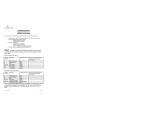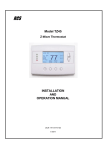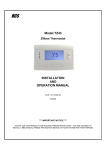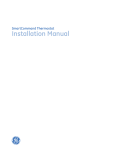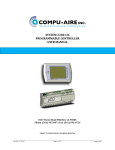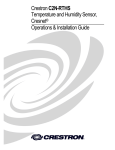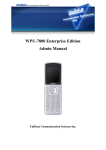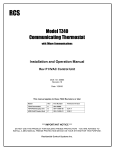Download CH-THSTAT-W Operation Guide (Doc ID 223 Rev 02)
Transcript
™ Operations Guide Model CH-THSTAT-W Wi-Fi Thermostat Main Thermostat Screen Backlite Display Room Temperature Room RH Setpoints Temperature Setting 4:30 PM Sys Off Fan Off Hold Link OK System Status Indicators MENU 74 2 COOL MODE AUTO FAN RH 40% 72 H 75 C Warmer Cooler HOLD Menu Selection Run/Hold Mode Selection Heating/Cooling Mode Selection Fan Mode Selection Minimized Display (displayed after screen timeout 75 Press any button to return to the main thermostat screen Doc ID 2014-05-223 • Rev 02 Page 1 Setting the heating or cooling temperature setpoint 4:30 PM Sys Off MENU 75 HEAT MODE AUTO FAN 64H Press a button to go to the setpoint change screen 82C HOLD Press the up or down arrow buttons to set the desired temperature setpoint Setpoint change screen HEATING SETPOINT 70 Done Raise Temperature Lower Temperature COOL Pressing the up or down buttons will increment the setpoint 1 degree. Press and hold the button to ramp the setpoint. Change Mode button Press “DONE” button to set the setpoint and exit back to the main thermostat screen or wait for the screen to automatically time out. ! If the System Mode is OFF, pressing either the Up or Down buttons will take you to the System Mode screen. You must first set an operating mode before you can set or change the setpoint. ! To change the Heat Setpoint you must be in the Heating mode, to change the Cool Setpoint you must be in the Cooling mode. If you are in Auto mode, the mode of the last system call will be the setpoint screen displayed. Press the Change Mode button to toggle between Heat and Cool mode. Setpoint Push: Note that you cannot lower the cooling setpoint below the heating setpoint. The thermostat will “push” the heating setpoint lower if you try to lower the cooling setpoint below the heating setpoint. It maintains a 3 degree separation between the heating and cooling setpoint. The same is true for raising the heating setpoint above the cooling setpoint. Again the thermostat will “push” the cooling setpoint up to maintain the 3 degree separation. Doc ID 2014-05-223 • Rev 02 Page 2 Setting the System Mode: Off, Heat, Cool, Auto 4:30 PM 75 Sys Off MENU HEAT MODE AUTO FAN 64H 82C HOLD Press Mode button to change system mode System Mode change screen SYSTEM MODE OFF HEATING COOLING AUTO Done MODE Press the UP or DOWN buttons or MODE button to select the desired system mode. Press “DONE” button to select the mode and exit back to the main thermostat screen or wait for the screen to automatically time out. System Modes • OFF: System is off. No heating or cooling will come on. If system was on, it will turn off immediately. • HEATING: Only heating will occur. • COOLING: Only cooling will occur. • AUTO: Heating or cooling will come on according to the heating and cooling setpoints. The system will automatically switch between heating and cooling modes as needed to maintain the setpoints. Special Heat Pump Mode: Emergency Heat • EHEAT: An additional system mode, “EHEAT” for Emergency Heat will be displayed if the HVAC system type is set to Heat Pump. If there is a compressor failure with the Heat Pump system, setting the mode to EHEAT will allow the supplemental Aux heat to come on first whenever there is a call for heating. It also disables the compressor output to prevent further damage to the HVAC system. Doc ID 2014-05-223 • Rev 02 Page 3 Setting Fan Mode and System Status Indicators 4:30 PM System Status Indicators Cool Fan On Hold Link Ok MENU RH 40% 75 HEAT MODE AUTO FAN 64H 82C HOLD Press the Fan button to change the Fan mode • • AUTO FAN: Fan automatically operated by the HVAC system. FAN ON: Manual Fan mode. Fan stays on until mode is changed back to Auto. Optional Fan Mode Fan Cycler. If the Fan Cycler feature is enabled in the Installer Setup, the additional fan mode “Cycle” will be shown in the Fan Mode menu. This mode cycles the fan on and off continuously for fresh air ventilation according to the settings in the Installer Setup. System Status Indicators When the main thermostat screen is displayed, the on-screen labels indicate the following. System Operation mode indicator “SYS OFF” displayed > System is OFF 1 “SYS MOT” displayed > System is OFF and Minimum Off Time (MOT) delay On is active “HEAT ON” displayed > System is ON and heating “COOL ON” displayed > System is ON and cooling 2 “HEAT MRT” displayed > System is ON and heating. Minimum Run Time (MRT) delay off is active. “COOL MRT” displayed > System is ON and cooling. Minimum Run Time (MRT) delay off is active. Staging display nd “2 Stg” displayed > Stage 2 heating or cooling is ON “Aux Heat” displayed > Stage 3 heating is ON For Heat Pump systems only: “EHEAT” > emergency heat mode active Home/Away display Home mode is active (current setpoints are being used) Away setback mode is active (setback setpoints are being used) System Alerts Alert Messages:Filter or Maintenance Timer WiFi Network connection Status: No Link, Link OK, TCP Notes 1 and 2: See MOT and MRT descriptions on page 5 Doc ID 2014-05-223 • Rev 02 Page 4 Thermostat Operation Minimum Run Time (MRT) The thermostat has a Minimum Run Time after the start of any heating or cooling call. This minimum run time assures even heating and cooling cycles. The MRT delay will keep the system on even if reaches setpoint or you change the setpoint to a temperature that would satisfy the call, until the MRT expires. Changing the Mode to OFF will cancel the MRT and the system will turn off immediately. The MRT can be adjusted in the Installer Settings menu of the thermostat. Note: The MRT status is shown in the thermostat System Status on-screen labels. Minimum Off Time (MOT) The thermostat has a Minimum Off Time after any heating or cooling call is finished. This delay prevents rapid heating/cooling cycles and also provides “short cycle protection” for compressor calls. This delay may be noticeable when you change a setpoint and it does not respond immediately due to another call that has recently completed and the MOT delay timer is preventing the system from restarting. The MOT delay time can be adjusted in the Installer Settings menu of the thermostat. There is a minimum of 5 minutes delay to assure compressor protection. Note: The MOT status is shown in the thermostat System Status on-screen labels. Doc ID 2014-05-223 • Rev 02 Page 5 Menu Selection 4:30 PM Sys Off MENU 75 HEAT MODE AUTO FAN 64H 82C HOLD Press Menu button to go to the main menu screen Menu Selection User Settings Humidity Settings Thermostat Info WiFi Network Status Done Press DONE to go back to the main thermostat screen Select Use the UP/DOWN buttons to select the desired menu item Press SELECT to go to the menu item screen Main Menu Items • • • • • • • Schedules > Optional, used to view and set programmable schedules User Settings > set various user preferences Usage Graph > show heating and cooling run times Away Setpoints > show and set the heating and cooling setback setpoints Thermostat Info > displays thermostat setup info WiFi Network Status > displays IP Network Info WiFi Setup > Set IP Network parameters Schedules is an optional menu item. It will only show up in the menu list if “Schedules” is enabled in the Installer settings for the thermostat. Provides for local schedule control. The Schedules Screen allows you to review and set the setback schedule for the thermostat. The thermostat has a 4 x 7 schedule. Four times a day can be selected for changes to the heating and cooling setpoints. Each day of the week can have a different schedule. Groups of days can be copied with the same schedule. When the thermostat is set to “Run” mode, the schedule will be executed daily, with the setpoints being changed as per that days schedule stored in the thermostat. “Hold” mode stops schedule operation and holds the current setpoints until changed manually or by network commands. Doc ID 2014-05-223 • Rev 02 Page 6 The Schedules Screen gives you the option of setting a custom setback schedule or to load one of two preset schedules. Menu Options Select Schedule • Heat and Cool: You can change the individual Heat and Cool day/hour and setpoints for the Heating and Cooling schedule Preset: Comfort by selecting this menu item. Preset: Energy Miser • Preset: Comfort: This is a preset schedule with mild setbacks. Select this menu item to load the Comfort Done Select schedule into the thermostat. Confirmation screen will be displayed for Yes/No entry. • Preset: EnergyMiser: This is a preset schedule with deeper setbacks. Select this menu item to load the EnergyMiser schedule into the thermostat. Confirmation screen will be displayed for Yes/No entry. Schedule Screen When you select the Heat and Cool Schedule menu item, the “day” schedule programming screen opens and the schedule for current day will be displayed. Use the scroll buttons to highlight the data to be modified. Once the data has been highlighted, use the +/- buttons to change the value of the data. Monday Schedule Wake Day Eve Sleep Time Heat 06:00 A 70 08:00 A 62 04:00 P 70 10:00 P 62 + - Cool 79 85 78 82 C DONE NEXT To copy a days schedule to another day or group of days, move the cursor to “C” on the bottom right of the schedule screen. When you highlight the “c”, the button below will become “Copy”. Press this button to change to the Copy Schedule Screen. Copy Schedule Screen The Copy Schedule screen is a sub screen of the Schedule screen. The Copy Schedule screen allows you to copy a day’s schedule to another day or group of days. First select the day to be copied in the Schedule screen. Scroll to the “c” at the bottom of the Schedule screen to highlight it. The “Next” button will change to the “Copy” button. Press the “Copy” button to open the Copy Schedule screen. Copy Monday Schedule T0 Yes Tue Wed Thu Fri Sat Sun N N N N N N BACK No COPY Scroll through the days and select the days you want to copy the schedule to by setting the “N” under each day to “Y” by using the Yes/No buttons. After selecting all the days desired, press the “COPY” button. Exit the Copy Schedule screen with the “DONE” button. User Settings Menu Items • • • • • • • User Settings Set Clock Filter Service Maint Service Screen Timeout 0 Set Clock > go to the clock setting screen Filter Service > go to the filter timer setup screen Done Maint Service > go to the maintenance timer setup screen Screen Timeout > sets the time in seconds to switch to the minimized screen F/C Settings > go to the F/C mode selection screen Sensor Calibration > go to the sensor calibration screen Backlight/Display > go to the backlight and display setup screen Doc ID 2014-05-223 • Rev 02 Select Page 7 Set Clock: The Set Clock screen allows you to set the Thermostat’s internal clock. To set the Time and Date, move the cursor with the navigation arrows until the data you want to change is highlighted. Using the + and – buttons to increment or decrement the data to the desired setting. Set Clock Time Date Day 08:00 AM 01/01/11 Mon Back + Set When finished, press the SET button to return to the Main Menu screen or wait for screen to timeout. ! If the clock has been reset by an extended power outage, the Clock display on the thermostat screen will be blinking. Pressing the MENU button will take you directly to this screen to set the clock. Filter Service: Go to the Filter Service Screen. Sets/resets the filter timer/alert. Shows filter runtime in hours and the service interval alert in hours (typically 300 hrs) Change the service interval with the +/- buttons. Reset the service alert after you have changed the filter. Maint Service: Go to the Maintenance Service Screen. Sets/resets the maintenance timer/alert. The Maintenance Service screen will show the accumulated Heat and Cool runtime hours as well as the Service Interval that will be used to trigger a Maintenance alert. Service interval is 3000 hours. Use the +/- buttons to adjust service interval. Press reset to clear the service alert and reset the runtimes to zero. When the combined HEAT and COOL Runtime hours equals the Service Interval hours, a “Maint” message will be displayed as a reminder that the HVAC system may require periodic maintenance. Pressing the Menu button will take you to the Filter Service screen. The Reset button can be pressed and the HEAT and COOL Runtime values will be reset to zero. Screen Timeout: Minimized Screen. Set the display timeout time in seconds. Options are 0 or 15 to 120 (default set to 0 seconds). This is the time before the main thermostat screen reverts to the minimized screen of temperature only, after the last button press. The Minimized Screen feature is disabled by setting this time to “0”. ! Any button press will restore the main thermostat screen display. F/C Settings: Go to the F/C Settings Screen. Select which temperature display mode you desire, Fahrenheit (F) or Celsius (C). Sensor Calibration: Go to the Sensor Calibration Screen. This screen allows you to adjust the calibration of the internal sensor. You can change the temperature calibration by +/- 7 degrees using the + and – buttons When the Sensor Calibration screen is selected it will show the current temperature calibration and the current number of degrees of offset being applied (typically 0). If the sensor’s actual temp is (74) with 0 degrees of offset and you want it to show 75, then press “+” to add 1 deg and it will show (75). ! You can refresh the info on this screen by pressing the right hand (blank) button. When you close this screen, it may take a few seconds for the temperature displayed on the main thermostat screen to update to the new temperature selected. Doc ID 2014-05-223 • Rev 02 Page 8 Backlite/Display: Go to the Backlite/Display settings screen. This menu allows you to set the backlight timeout period and adjust the display contrast. Backlite Timeout: Sets the time from last button press that the backlite will timeout and turn off. The timeout value is adjustable from 0 or 20 to 120 seconds. If set to “0”, the Backlite will always be ON. If set in the range of 20 to 120 seconds, the Backlite will turn OFF after the selected time expires. ON Level: Sets the backlight brightness when it is on. Adjustable from 0 to 100% in 5% steps. Screen will change brightness as you adjust setting. OFF Level: Sets the backlight brightness when it is off. Adjustable from 0 to 100% in 5% steps. Can be 0% = off or a low level for night viewing. Contrast: Sets the contrast level of the LCD display, adjustable from 0 to 20. Use this control to adjust the sharpness of the display. To light and the display looks faded, too dark and dark lines will appear in the display. Typically 10-15 is a good setting. Adjust as needed. Humidity Settings Select Humidity Settings menu item to set the RH mode and RH setpoint. RH Mode. On or OFF. Enables Humidity Control. Default set to Off. When RH mode is ON, the thermostat will compare the room RH with the RH setpoint to determine if dehumidification control is needed. If RH is above the RH setpoint, the thermostat will continue cooling calls to attempt to lower the room RH to the meet the RH setpoint. Maximum overcooling is limited to 2 deg (adjustable in the Installer Settings). RH Setpoint. Adjustable from 20 to 80%. Default set to 55%. The RH setpoint is the humidity level the thermostat will attempt to meet when humidity control (RH Mode) is On. Away Setpoints (optional – enable in installer settings) Away setpoints are used when the thermostat is set to the setback or away mode. Away Setpoints Away – Heat Away – Cool Done Press DONE to store the setting and exit back to the main menu + 65 80 - Use up/down buttons to select setpoint to change Set Use +/- buttons to increase or decrease the temperature Thermostat Info The Thermostat Info screen displays the current configuration of the thermostat. This information is useful for quick check of firmware versions and HVAC system setup. It also shows the WiFi radio firmware version. Thermostat information displayed is: • • • • Thermostat Version - Model and firmware version number. WiFi Radio Version – Firmware version of the WiFi radio System Type - Standard or Heat Pump HVAC system Fan Type – if HVAC type = Standard: Gas or Elect Doc ID 2014-05-223 • Rev 02 Page 9 • • OR Changeover – if HVAC type = Heat Pump: Changeover with cool or changeover with heat Network Address – This is an internal address, not the IP address Thermostat Info Screen Thermostat Info Model Number WiFi Radio Version: System Type: Fan Type: Network Address: Done Status Ver: 02.07.01 02.36 Standard Gas 1 Setup Status Button: Pressing the Status button will display the status of the thermostat relay outputs. This can be helpful information in trouble shooting installation problems. Setup Button: This is a quick link to the mechanical setup for the HVAC system type. If your HVAC is not the default HVAC type (Standard/Gas) or does not match the settings displayed, press this button to go directly to the Installer Settings/Mechanical settings menu to set the correct settings. Doc ID 2014-05-223 • Rev 02 Page 10 WiFi Setup WiFi Network Status Screen WiFi Network Status SSID: A Chan: 6 Security: Open DHCP: ON IP: 192.168.1.100 : 2000 SUB: 255.255.255.0 Auth: Y GW: 192.168.1.1 Assoc: Y Done This screen is selected from the main menu and displays the current WiFi network parameters: SSID: Current network the thermostat is connected to Channel: Current WiFi channel Security: Security protocol: Adhoc, Open, WEP, WPA1,WPA2, IP: IP address assigned to the thermostat Sub: Subnet mask GW: Gateway IP address Auth: Authenticated status by network Assoc: Associated status with network WiFi Setup Menu WiFi Setup WPS Connect SSID A DHCP Enabled Security WPA2 Done Select This screen is selected from the main menu to setup up the thermostat’s WiFi connection parameters. Menu items include: • • • • • • • • • • • • • • • WPS Connect SSID DHCP Security Key IP SUB GW DNS Port Chan Adhoc Mode Reset Time Reboot Radio Restore Radio WPS Connect If the network router has WPS (Wi-Fi Protected Setup) capability, the thermostat can automatically find and join a secure Wi-Fi network. • Place the Router / Access Point into WPS mode • In the WiFi Setup screen, select WPS Connect and press the “Select” button. • A WPS Connection progress window will pop up and indicate WPS status Doc ID 2014-05-223 • Rev 02 Page 11 Upon successful completion, the WiFi Network Status screen will be displayed • SSID Select SSID and press the “Select” button to scan for available networks. After the thermostat completes a network scan, the available networks will be displayed. Use the up/down arrow buttons to scroll through the available networks WiFi Networks Network1 Network2 Network3 Network4 Done New II IIII II III Scan Shows network SSID, signal strength and open / locked network status Join Press Join to join the selected network Press Scan to scan again Press New to enter a new SSID network name to join DHCP Configuration If the network router supplies IP address Dynamically (DHCP): • Select “SSID” from list shown on screen, press “Join” button • Or, press the Scan button to rescan for SSID • Or, manually enter the SSID network name (Case / character capable) • Select DHCP enabled (this is the default mode) • Once the router / SSID is selected, the WiFi radio will auto-detect the appropriate security protocol • Or, manually select the security type (Adhoc, WPA1, WPA2, WPA1+WPA2, WEP) • Enter the security key (Case sensitive and character capable) • Select Done to save settings Security Select the security type for the network selected: Adhoc, Open, WEP, WPA1,WPA2 Key Enter the Passphrase for the network selected. IP Address (for static IP configurations) To set a Static IP address: WiFi Setup Key xxxxxxxx • Disable DHCP by pressing the “-“ key IP 0.0.0.0 • Enter IP Address (if static IP) SUB 0.0.0.0 GW 0.0.0.0 • Enter the Subnet Mask Done • Enter the Default Gateway address • Enter the DNS address • Enter the Port number. The WiFi radio communicates on Port 2000, this should be left in the default setting • Enter the Channel number. Auto mode is the default (recommended) • Select Done to save settings Select Ad Hoc Mode The Wi-Fi radio can also be placed into Ad Hoc mode which enables Peer-to-Peer communication without a network router. • Select Ad Hoc in the Setup menu. The default mode is Disabled • Press the “+” key to change to Enabled o sets the thermostat IP address to: 169.254.1.1 o sets the Subnet to: 255.255.0.0 • Select Done to save settings Doc ID 2014-05-223 • Rev 02 Page 12 Reset Time The thermostat can auto reset the WiFi radio if no active communications occurs during the time period set by the Reset Time. Default set to Off. Reboot Radio Resets the WiFi radio. Current network settings are not changed. Restore Radio Restores WiFi radio to factory settings. All the current network settings are reset. Network Status Indicators • No Link: no connection to a WiFi network • Link OK: connected to a WiFi network • TCP: communication session in progress between the thermostat and a network application. Doc ID 2014-05-223 • Rev 02 Page 13 FCC/IC INFORMATION TO USER This device complies with Part 15 of the FCC Rules. Operation is subject to the following two conditions: (1) This device may not cause harmful interference, and (2) This device must accept any interference received, including interference that may cause undesired operation. This equipment has been tested and found to comply with the limits for Class B Digital Device, pursuant to Part 15 of the FCC Rules. These limits are designed to provide reasonable protection against harmful interference in a residential installation. This equipment generates and can radiate radio frequency energy and, if not installed and used in accordance with the instructions, may cause harmful interference to radio communications. However, there is no guarantee that interference will not occur in a particular installation. If this equipment does cause harmful interference to radio or television reception, which can be determined by turning the equipment off and on, the user is encouraged to try to correct the interference by one or more of the following measures. • • • • Reorient or relocate the receiving antenna Increase the separation between the equipment and receiver Connect the equipment into an outlet on a circuit different from that to which the receiver is connected Consult the dealer or an experienced radio/TV technician for help Any changes or modifications not expressly approved by the party responsible for compliance could void the user’s authority to operate the equipment. This device complies with Industry Canada license-exempt RSS standard(s). Operation is subject to the following two conditions: (1) this device may not cause interference, and (2) this device must accept any interference, including interference that may cause undesired operation of the device. Le présent appareil est conforme aux CNR d'Industrie Canada applicables aux appareils radio exempts de licence. L'exploitation est autorisée aux deux conditions suivantes : (1) l'appareil ne doit pas produire de brouillage, et (2) l'utilisateur de l'appareil doit accepter tout brouillage radioélectrique subi, même si le brouillage est susceptible d'en compromettre le fonctionnement. Doc ID 2014-05-223 • Rev 02 Page 14














